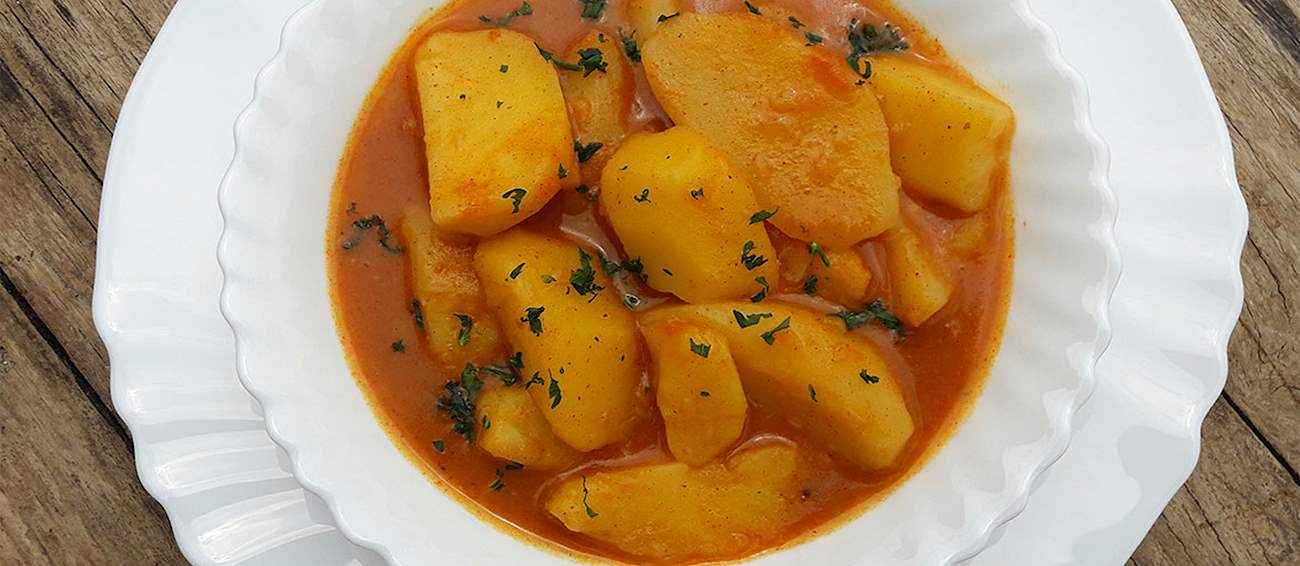MAIN INGREDIENTS
Out of the numerous varieties of Croatian brudet, the one that hails from the Neretva region is considered unique since it usually employs eels and frogs, two traditional ingredients used in the area. It is said that every village in the region has a different recipe, but the basic version employs thoroughly cleaned pieces of eels and frogs that are sautéed alongside olive oil, onions, and garlic.
They are later braised in a combination of seafood stock, fresh tomatoes, chili peppers, and a touch of vinegar. Though tradition suggests the use of eels and frogs, the dish is commonly enriched with other fish varieties. Regardless of the differences, every version of brudet is always prepared in a traditional, heavy-bottomed pan and should never be stirred.
MAIN INGREDIENTS
Ćoravi gulaš is a variety of goulash consisting of potatoes, onions, carrots, peas, and tomato juice. It is typically flavored with ground paprika, parsley, salt, pepper, bay leaves, and garlic. The stew can be thickened with flour, and it can be garnished with a dollop of sour cream.
The name of the dish can be translated as blind goulash, referring to the fact that this comforting stew does not contain any meat. The dish was especially popular during the war period in the 1990s, when meat was scarce, so people had to make use of readily available ingredients.
Istrian maneštra is a Croatian take on the popular Italian minestrone soup. This hearty and thick stew-like soup is made with dried meat, beans, and spring corn. There are numerous variations on the dish, so maneštra is typically served as the first course when dried meat is omitted, and if it is prepared with meat, the dish is then usually served as a main course.
Carrots, celery, turnips, onions, and tomatoes can all be used in maneštra, which is often flavored with parsley, black pepper, olive oil, and bay leaves. There is also the annual Maneštra Festival in the county of Gračišće.
VARIATIONS OF Maneštra
MAIN INGREDIENTS
Kupus s mesom is a typical winter dish prepared in the Croatian region of Lika. It consists of only two ingredients – sour cabbage and dried pork meat such as ribs, ham, and bacon. The meat should be washed and boiled first in order for it not to be too salty and overpowering.
A big pot is typically filled with sour cabbage, a layer of meat, and another layer of sour cabbage on top. The dish is cooked for about 2 hours over low heat. When served, it is often accompanied by baked potato halves on the side.
This comforting bean stew made with shredded pickled turnip (kisela repa) or sauerkraut (kiselo zelje) is traditionally prepared in northern parts of Croatia. To prepare it, dried beans are soaked overnight, boiled with smoked pork shin or ribs and bacon until cooked, then combined with pickled vegetables.
The final touch lies in the thickening with a mixture of fried crushed garlic and a small amount of flour. Grah s kiselom repom is best enjoyed with slices of crusty homemade bread, and it tastes even better when paired with cooked sausages.
MAIN INGREDIENTS
Istarska jota is an old dish that has been considered a poor man’s meal in the past. It is made with simple ingredients such as beans, sauerkraut or sour turnips, potatoes, bacon, spare ribs, onions, and garlic. All of the ingredients are seasoned with a few selected spices.
The only constants of the dish are sauerkraut and olive oil, an unusual blend of Mediterranean and Central European influences on the region. This stew or thick soup is extremely popular in Istria and north-western Croatia, but also in parts of Slovenia and north-eastern Italy, specifically the territories that were under the Austro-Hungarian rule.
MAIN INGREDIENTS
Fiš paprikaš (or hal paprikas in Hungary, with the addition of sour cream) is a traditional stew cooked in a big cauldron over an open fire. This spicy fish stew is traditionally made with a variety of freshwater fish such as catfish, starlet, pike, and carp.
The stew is heavily flavored with large amounts of the region's staple – ground red paprika, which can range from mild to very hot. Fiš paprikaš is often served with homemade noodles, and it is so popular in the region that there are numerous fiš cooking competitions organized throughout the year.
MOST ICONIC Fiš paprikaš
View moreMAIN INGREDIENTS
This simple fish stew with potatoes is said to be the oldest way of preparing fish in Dalmatia and was probably brought to the area by Greek settlers more than 2000 years ago, although potatoes are a local modification because they were introduced considerably later.
Traditionally, the dish is made by layering together thinly sliced potatoes and onions which are then drizzled with olive oil, topped with smaller white saltwater fish, and cooked in just enough water and white wine to cover the fish—usually with the addition of parsley and garlic, whereas modern recipes often include ingredients such as capers and salted anchovies.
MOST ICONIC Gregada
View moreMAIN INGREDIENTS
Sataraš is a vegetable stew made with a combination of tomatoes, peppers, onions, garlic, and parsley. The ingredients are first fried, then seasoned with salt and pepper and gently stewed. It is recommended to use a wide pan while preparing the dish so that the liquid evaporates more quickly, while the vegetables retain the desired shape and texture.
Sataraš can be eaten hot or cold. It can be served on its own or as an accompaniment to fried meat and fish dishes. In Croatia, when sataraš was served in the past, the head of the family would sometimes ask for a sunny-side-up egg or two to be placed on top of the dish (making the meal non-vegan with his request).
TasteAtlas food rankings are based on the ratings of the TasteAtlas audience, with a series of mechanisms that recognize real users and that ignore bot, nationalist or local patriotic ratings, and give additional value to the ratings of users that the system recognizes as knowledgeable. TasteAtlas Rankings should not be seen as the final global conclusion about food. Their purpose is to promote excellent local foods, instill pride in traditional dishes, and arouse curiosity about dishes you haven’t tried.












